George Bellows’ Stag at Sharkey’s provides a compelling entry point for an inquiry study into the gritty world of prizefighting and its connection to evolving notions of masculinity in turn-of-the-century America.
In the early 1900s, prizefighting was a wildly popular yet brutal sport, offering fame and fortune to a fortunate few while leaving many athletes physically and financially broken. In New York City, boxing was undergoing a transformation—from a bloody spectacle to the disciplined “sweet science of bruising.” This inquiry study invites students to explore this pivotal shift, uncovering the social and cultural forces that shaped both George Bellows’ art and the dynamic era he depicted.
Using news accounts from The Evening World, Joseph Pulitzer’s sensational newspaper that catered to New York’s growing immigrant population, students research stories of their choosing. The paper’s dramatic accounts, lively illustrations, and bold advertisements provide an entertaining and insightful lens into the times. These historical artifacts also offer students opportunities to analyze point of view and uncover societal values. Through this lens, students can examine turn-of-the-century notions of masculinity and reflect on what this controversial pastime reveals about the cultural attitudes of the period.
Before launching an inquiry study it is important to have students experience a work of art on their own terms. Use this opportunity to build background knowledge, engage empathy, and spark wonderings. This link offers teaching moves and language for introducing students to George Bellows’ Stag at Sharkey’s.
O. Henry (William Sydney Porter) introduces New York City and the protagonists in his short story The Duel with the following lines
But every man Jack when he first sets foot on the stones of Manhattan has got to fight. He has got to fight at once until either he or his adversary wins. There is no resting between rounds, for there are no rounds. It is slugging from the first. It is a fight to a finish.…
They came out of the West together, where they had been friends. They came to dig their fortunes out of the big city. Father Knickerbocker met them at the ferry, giving one a right-hander on the nose and the other an upper-cut with his left, just to let them know that the fight was on. William was for business; Jack was for Art. Both were young and ambitious; so they countered and clinched.
O. Henry and George Bellows both appreciated prizefighting as a sport and as a metaphor. A society’s favored pastimes offer insight into its interests and values. At the turn of the 20th century the sport of boxing was finding its way. In New York City it was transitioning from a blood sport to the sweet science of bruising. Researching this transition provides insight into the world that shaped Bellows’ art and times, and it likewise offers an opportunity to reflect on what our pastimes say about us as a society.
What firsthand resource could students use to research their interests? Joseph Pulitzer’s daily The Evening World catered to New York’s growing immigrant population and pioneered his special brand of sensational “yellow journalism.” This daily introduced a sports section just as boxing was being outlawed in New York and clandestine prizefighting stags became the rage, the same fights that inspired Bellows’ Stag at Starkey’s. The daily’s gripping accounts, comical illustrations, and over-the-top advertisements make for fun and insightful reading and research.
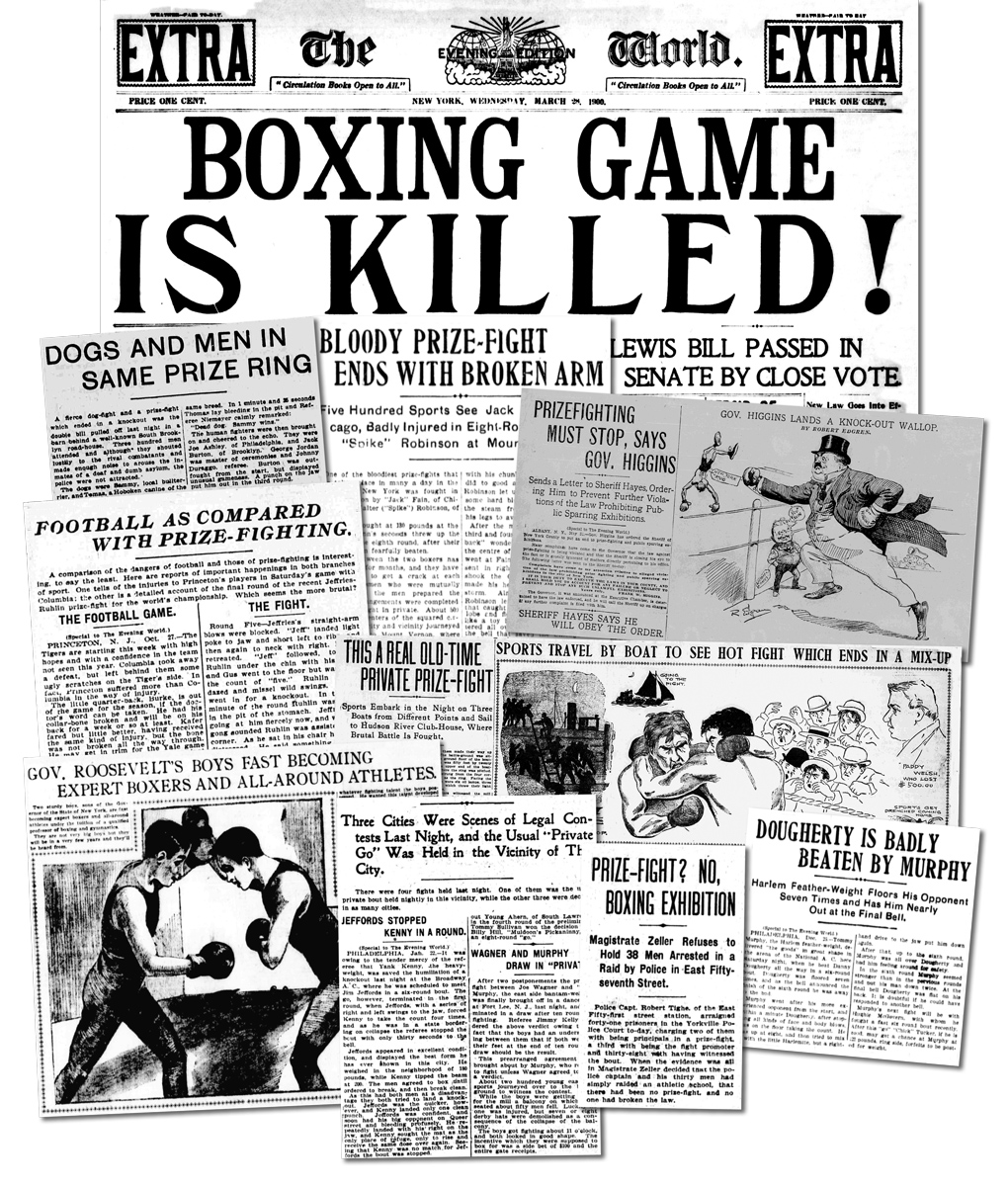 How will students access these old sports sections? Wait for it. Wait for it. Voila, the Library of Congress to the rescue. Their fantastic Chronicling America Historic American Newspaper site is an awesome educational resource and makes me proud that my tax dollars were spent so well. It is staggering how accessible and comprehensive this research base is. If students want to sift through the newspapers, then I recommend the advanced search function and narrow your search parameters to ”prize-fight” or “boxing” between the years 1900–1920. Even with that you will be overwhelmed with the offerings so further limit the search to the newspaper “The Evening World (New York, N.Y.)”
How will students access these old sports sections? Wait for it. Wait for it. Voila, the Library of Congress to the rescue. Their fantastic Chronicling America Historic American Newspaper site is an awesome educational resource and makes me proud that my tax dollars were spent so well. It is staggering how accessible and comprehensive this research base is. If students want to sift through the newspapers, then I recommend the advanced search function and narrow your search parameters to ”prize-fight” or “boxing” between the years 1900–1920. Even with that you will be overwhelmed with the offerings so further limit the search to the newspaper “The Evening World (New York, N.Y.)”
The news stories below are organized around some common themes. Have students read stories that interest them and share what they have learned. As historical artifacts, these articles also offer students opportunities to read for point of view and explore values. Have students note especially how these articles and the neighboring advertisements define masculinity.
The Question Formulation Technique (QFT) can help turn art observations and wonderings into inquiry-based research questions that build on student insights and interests. For ideas on how to structure inquiry circle see Stefanie Harvey and Smokey Daniels Comprehension and Collaboration: Inquiry Circles for Curiosity, Engagement, and Understanding. Matt Horgan’s Blood Sport in Pittsburgh: An Analysis of Prize Fighting and Cock Fighting in an American Industrial City models how to use newspaper accounts about prizefighting to write a research paper that explore societal trends in turn-of-the-century United States.
One way to rally this research into a creative class project is to simulate a sports page around the events in Stag at Sharkey’s. This could include a descriptive story about the fight; dialogue-rich interviews with the fighters, referee, Tom Sharkey, or members of the crowd; editorials condemning or promoting prize-fighting; spoof advertisement that address male ailments; and illustrations or cartoons. Here is a gallery of telling articles. Click on an image for a closer look.
General
- “Eddie Hanlon Wins Fierce Fight from Broad in the Fourteenth Round,” The Evening World. (New York, N.Y.), 30 Jan. 1904, page 4. This sports page is chock full of fight news and is an ideal shared text for exploring the landscape of turn-of-the-century boxing. It reflects the widespread prestige of the sport. In one story a police raid breaks up a “private club fight” in New York. In another story racism plays a role in an unjust decision in Chicago. Masculinity is defined by the advertisements and news accounts.
Brutality and Savagery
The law banning boxing drove prizefighting underground, exacerbating the very corruption and brutality they hoped to squelch.
- “Football as Compared with Prize-Fighting,” The Evening World. (New York, N.Y.), 27 Oct. 1902, page 8. Comparing the injuries from a Princeton-Columbia football game with those from the Jeffries-Ruhlin fight links the sports—and our times. Note the small neighboring story on a fatal concussion suffered during a football game. Does football have the same atavistic allure as prizefighting did and will it fade from the headlines as boxing has?
- “Dogs and Men in the Same Prize Ring,” The Evening World. (New York, N.Y.), 18 Sept. 1903, page 10. Sweet science of bruising or blood sport? This article offers evidence to the latter. Note the neighboring story on a questionable decision and the medical advertisement promising to “cure men.” A lot of themes here wrapped up in one sports page.
- “Bloody Prize-Fight Ends with Broken Arm,” The Evening World. (New York, N.Y.), 26 Dec. 1904, page 5. This detailed description of a brutal eight round fight lets you join 400+ sporstmen who “went to see a bloodthirsty battle, and every mother’s son of them went home perfectly satisfied.”
- “Roosevelt Will Probe Fatal Bout,” The Evening World. (New York, N.Y.), 08 Nov. 1905, page 7. A grudge fight between midshipmen results in death and lands on President Roosevelt’s desk for investigation.
Gambling and Criminality
- “This a Real Old-Time Private Prize-Fight,” The Evening World. (New York, N.Y.), 22 June 1904. Under the cover of darkness three boats ferried fight fans and gamblers to a boat house for a match that ended in biting.
- “Prize Fighters Freed by Court,” The Evening World. (New York, N.Y.), 16 Jan. 1905, page 8. While a police raid is unable to distinguish a prizefight from a boxing exhibition, they do net several hidden revolvers.
- “Prize-Fight by Daylight in the Heart of the Financial District,” The Evening World. (New York, N.Y.), 06 April 1907, page 1. A clandestine gathering of 50 stockbrokers and businessmen gathered to watch and wager on a mid-day bout between Willie Mango and Emergency Kelly.
Political and Legal Hurdles
In 1900, the Lewis Law essentially outlawed prizefighting, except for fistic exhibitions in private boxing clubs. This loophole spawned illicit “fight clubs” where attendees paid membership dues instead of admission fees. The police and courts struggled to distinguish illegal prizefights from private boxing exhibitions. Partisan political infighting likewise informed the debate.
- “An Early Death for the Boxing Game,” The Evening World. (New York, N.Y.), 17 April 1900, page 8. The impending enactment of the Lewis Bill inspires boxing clubs and causes contenders to scurry to get their bouts in under the wire.
- “Boxing Game Is Killed,” The Evening World. (New York, N.Y.), 28 March 1900, pages 1 and 7. This headline grabbing news account describes the provisions of the Lewis Boxing Bill that banned professional boxing.
- “Three Cities Were Scenes of Legal Contests Last Night, and the Usual ‘Private Go’ was held in the Vicinity of this City,” The Evening World. (New York, N.Y.), 22 Jan. 1904. The absurdity around the fight club loophole induced as much hilarity in the press as it did consternation in the courts.
- “Senator Frawley Referee at this Prize Fight,” The Evening World. (New York, N.Y.), 22 April 1904. The New York State Senator who would eventually lead the effort to legalize boxing referees a club bout—and then denied it when approached by a reporter. The through-the-window exchange with the reporter is amusing considering the role he would eventually play in the sport.
- “Prizefighting Must Stop, Says Gov. Higgins,” The Evening World. (New York, N.Y.), 31 May 1906. Page 1. Efforts to prosecute an illegal prizefight unearth a private meeting of a wildly exuberant boxing club, or at least that is what the participants argue.
- “Boxing Game Knocked Out by Ruling of the Court,” The Evening World. (New York, N.Y.), 11 June 1906, page 1 and 2. Prizefight participants argue they box at night for exercise and pay regular club dues, not admissions fees.
- “Frawley Law May Mean Return of Old Days When Fortunes were Spent on Ring Battles,” The Evening World. (New York, N.Y.), 29 July 1911, page 6. Debate swirls on whether the boxing game will still be as lucrative with the Frawley bill’s new regulations.
- “Boxing Now Legalized in New York State,” The Evening World. (New York, N.Y.), 26 July 1911, page 8. While the boxing debate will continue in the statehouse, boxing is once again legalized and 10-round bouts are permitted in halls or open-air arenas like race tracks.
- “Commission Expects to Put Boxing on the Highest Plane,” The Evening world. (New York, N.Y.), 30 March 1912, page 6. Boxing supervisors plan further changes in rules that should give boxing the same standing as baseball.
“Sailor” Tom Sharkey
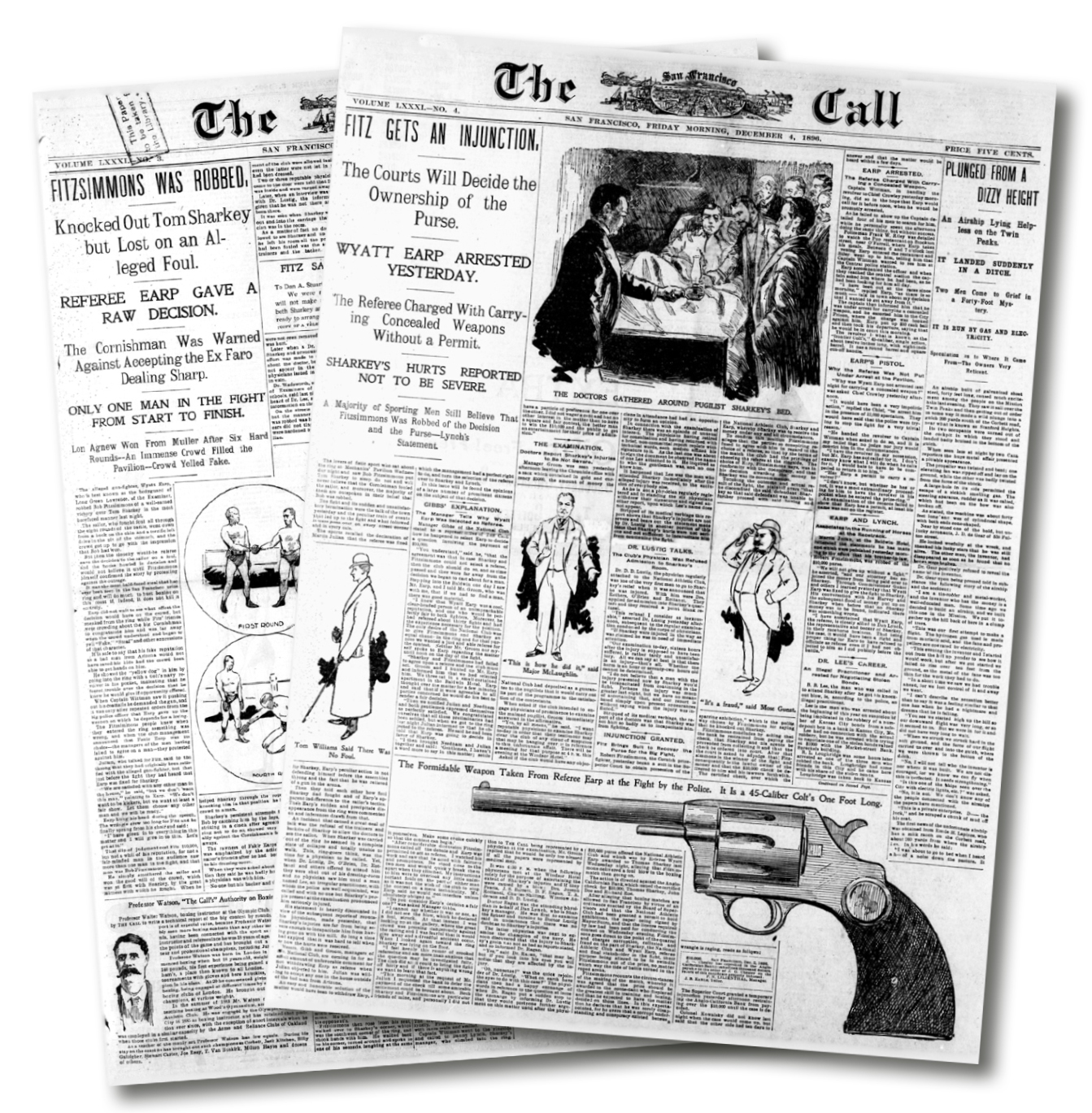 In addition to being the proprietor of the bar/fight club that Bellows frequented for some of his most famous boxing painting, Tom Sharkey was also a heavy weight contender. His career as a fighter and promoter is especially colorful and touches on the common themes explored here—brutality, criminality, finding a way out of poverty through fighting.
In addition to being the proprietor of the bar/fight club that Bellows frequented for some of his most famous boxing painting, Tom Sharkey was also a heavy weight contender. His career as a fighter and promoter is especially colorful and touches on the common themes explored here—brutality, criminality, finding a way out of poverty through fighting.
- “Fitzsimmons Was Robbed, Knocked Out Tom Sharkey but Lost on an Alleged Foul,” The San Francisco Call. (San Francisco [Calif.]), 03 Dec. 1896, Page 1. In his bout against Fitzsimmons, Sharkey gets knocked out but wins on a raw decision by referee Wyatt Earp. Yes, that Wyatt Earp, the gambler, buffalo hunter, gun fighter, and lawman who took part in the gunfight at the O.K. Corral. Was the fix in?
- “Fitz Gets An Injunction,” The San Francisco Call. (San Francisco [Calif.]), 04 Dec. 1896, page 1. As the dust settles from the Sharkey-Fitzsimmons bout, the list of misdeeds and skullduggery mount.
- “Jeffries the Victor,” The Sun. (New York [N.Y.]), 04 Nov. 1899, page 1. In a hard fought 25-round bout, Sharkey and Jeffries created a boxing classic. Sharkey suffered a broken nose, two broken ribs, and a horribly swollen ear.
- The Bioscope Festival of Lost Films shows a recreated excerpt of the 25-round, 2 hour fight between “Sailor” Tom Sharkey and Jim Jeffries, the last great fight of the 1800’s and the first match filmed.
- “Fitzsimmons and Sharkey Matched,” The Evening World. (New York, N.Y.), 05 March 1900, page 8. A news story recounts the planning of a 25-round winner-take-all boxing match. Neighboring articles describe Teddy Roosevelt’s sons’ boxing prowess.
- “Advance Report of To-night’s Fight, Round by Round, By Thomas Sharkey,” The Evening World. (New York, N.Y.), 30 Aug. 1900, page 2. Based on his experience fighting both men, “Sailor” Tom predicts the outcome of a big fight the night before the Lewis Law takes effect.
Male Identity / Masculine Ideals
These sports pages are rich with opportunities to explore turn-of-the-century views of masculinity. As students read, have them note references to the hyper-masculine ideals espoused on the sports pages and that Teddy Roosevelt carefully cultivated for his own public image—strength, stamina, toughness, fortitude, self-sufficiency, aggressive, confident, rugged, brash, charismatic, virile, courageous, honorable, independent, and heroic. While these fighters typically existed in exclusively male environments, there are articles about their wives and girlfriends that further highlight gender roles and ideals.


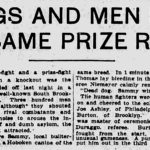
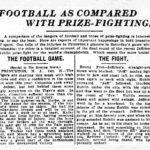
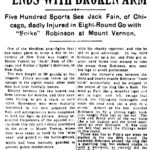
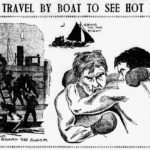
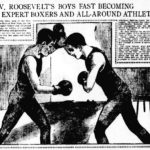
Comments are closed, but trackbacks and pingbacks are open.